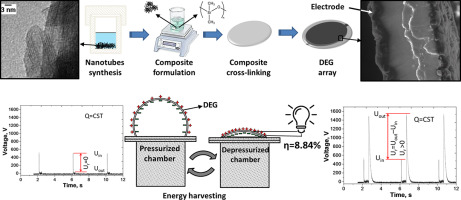当前位置:
X-MOL 学术
›
Mater. Des.
›
论文详情
Our official English website, www.x-mol.net, welcomes your feedback! (Note: you will need to create a separate account there.)
Ceramic nanotubes-based elastomer composites for applications in electromechanical transducers
Materials & Design ( IF 8.4 ) Pub Date : 2018-03-01 , DOI: 10.1016/j.matdes.2017.12.039 A. Bele , C. Tugui , L. Sacarescu , M. Iacob , G. Stiubianu , M. Dascalu , C. Racles , M. Cazacu
Materials & Design ( IF 8.4 ) Pub Date : 2018-03-01 , DOI: 10.1016/j.matdes.2017.12.039 A. Bele , C. Tugui , L. Sacarescu , M. Iacob , G. Stiubianu , M. Dascalu , C. Racles , M. Cazacu

|
Abstract Titanium dioxide-based nanoparticles with nanotube morphology were synthesised and used in low fractions (2 and 5 wt%) as dielectric permittivity enhancers for high molecular weight polydimethylsiloxane matrix (Mn = 350,000 g mol− 1). In order to ensure good dispersability in, and compatibility with the silicone matrix, the filler was treated with hexamethyldisilazane. The polymer composites were processed as films and stabilized by condensation of the chain ends with a trifunctional silane, resulting in low density cross-linking elastomers. The films were characterized for morphology, dielectric and mechanical behavior. The evaluated properties were compared with those measured in similar conditions for a pure cross-linked silicone matrix and a commercial dielectric elastomer taken as references. The results indicated an increase in dielectric permittivity (up to 33%), as a result of filler incorporation without significantly damaging dielectric strength (> 60 V μm− 1) and mechanical properties (elastic modulus as low as 0.4 MPa and high strains at break up to 600%). Electromechanical measurements revealed the best performance in actuation for the composite containing 2 wt% nanotubes (4.2% lateral strain at 40 V·μm− 1). Initial tests for energy harvesting performed with dielectric elastomer generators built with the same material sandwiched between two highly compliant electrodes yielded promising energy conversion efficiency (up to 8.84% at 2.5 V·μm− 1).
中文翻译:

用于机电换能器的陶瓷纳米管弹性体复合材料
摘要 合成了具有纳米管形态的基于二氧化钛的纳米粒子,并以低比例(2 和 5 重量%)用作高分子量聚二甲基硅氧烷基质(Mn = 350,000 g mol− 1)的介电常数增强剂。为了确保在有机硅基体中的良好分散性和相容性,填料用六甲基二硅氮烷处理。聚合物复合材料被加工成薄膜,并通过链端与三官能硅烷的缩合来稳定,从而产生低密度的交联弹性体。对薄膜的形态、介电和机械性能进行表征。将评估的性能与在类似条件下测量的纯交联有机硅基质和商用介电弹性体作为参考进行比较。结果表明介电常数增加(高达 33%),这是由于填料掺入而不会显着损害介电强度(> 60 V μm− 1)和机械性能(弹性模量低至 0.4 MPa 和高断裂应变)高达 600%)。机电测量显示,含有 2 wt% 纳米管(40 V·μm− 1 时的横向应变为 4.2%)的复合材料的驱动性能最佳。使用夹在两个高度顺应性电极之间的相同材料构建的介电弹性体发电机进行能量收集的初始测试产生了有希望的能量转换效率(在 2.5 V·μm- 1 时高达 8.84%)。60 V μm− 1) 和机械性能(弹性模量低至 0.4 MPa,断裂应变高达 600%)。机电测量显示,含有 2 wt% 纳米管(40 V·μm− 1 时的横向应变为 4.2%)的复合材料的驱动性能最佳。使用夹在两个高度顺应性电极之间的相同材料构建的介电弹性体发电机进行能量收集的初始测试产生了有希望的能量转换效率(在 2.5 V·μm- 1 时高达 8.84%)。60 V μm− 1) 和机械性能(弹性模量低至 0.4 MPa,断裂应变高达 600%)。机电测量显示,含有 2 wt% 纳米管(40 V·μm− 1 时的横向应变为 4.2%)的复合材料的驱动性能最佳。使用夹在两个高度顺应性电极之间的相同材料构建的介电弹性体发电机进行能量收集的初始测试产生了有希望的能量转换效率(在 2.5 V·μm- 1 时高达 8.84%)。
更新日期:2018-03-01
中文翻译:

用于机电换能器的陶瓷纳米管弹性体复合材料
摘要 合成了具有纳米管形态的基于二氧化钛的纳米粒子,并以低比例(2 和 5 重量%)用作高分子量聚二甲基硅氧烷基质(Mn = 350,000 g mol− 1)的介电常数增强剂。为了确保在有机硅基体中的良好分散性和相容性,填料用六甲基二硅氮烷处理。聚合物复合材料被加工成薄膜,并通过链端与三官能硅烷的缩合来稳定,从而产生低密度的交联弹性体。对薄膜的形态、介电和机械性能进行表征。将评估的性能与在类似条件下测量的纯交联有机硅基质和商用介电弹性体作为参考进行比较。结果表明介电常数增加(高达 33%),这是由于填料掺入而不会显着损害介电强度(> 60 V μm− 1)和机械性能(弹性模量低至 0.4 MPa 和高断裂应变)高达 600%)。机电测量显示,含有 2 wt% 纳米管(40 V·μm− 1 时的横向应变为 4.2%)的复合材料的驱动性能最佳。使用夹在两个高度顺应性电极之间的相同材料构建的介电弹性体发电机进行能量收集的初始测试产生了有希望的能量转换效率(在 2.5 V·μm- 1 时高达 8.84%)。60 V μm− 1) 和机械性能(弹性模量低至 0.4 MPa,断裂应变高达 600%)。机电测量显示,含有 2 wt% 纳米管(40 V·μm− 1 时的横向应变为 4.2%)的复合材料的驱动性能最佳。使用夹在两个高度顺应性电极之间的相同材料构建的介电弹性体发电机进行能量收集的初始测试产生了有希望的能量转换效率(在 2.5 V·μm- 1 时高达 8.84%)。60 V μm− 1) 和机械性能(弹性模量低至 0.4 MPa,断裂应变高达 600%)。机电测量显示,含有 2 wt% 纳米管(40 V·μm− 1 时的横向应变为 4.2%)的复合材料的驱动性能最佳。使用夹在两个高度顺应性电极之间的相同材料构建的介电弹性体发电机进行能量收集的初始测试产生了有希望的能量转换效率(在 2.5 V·μm- 1 时高达 8.84%)。



























 京公网安备 11010802027423号
京公网安备 11010802027423号